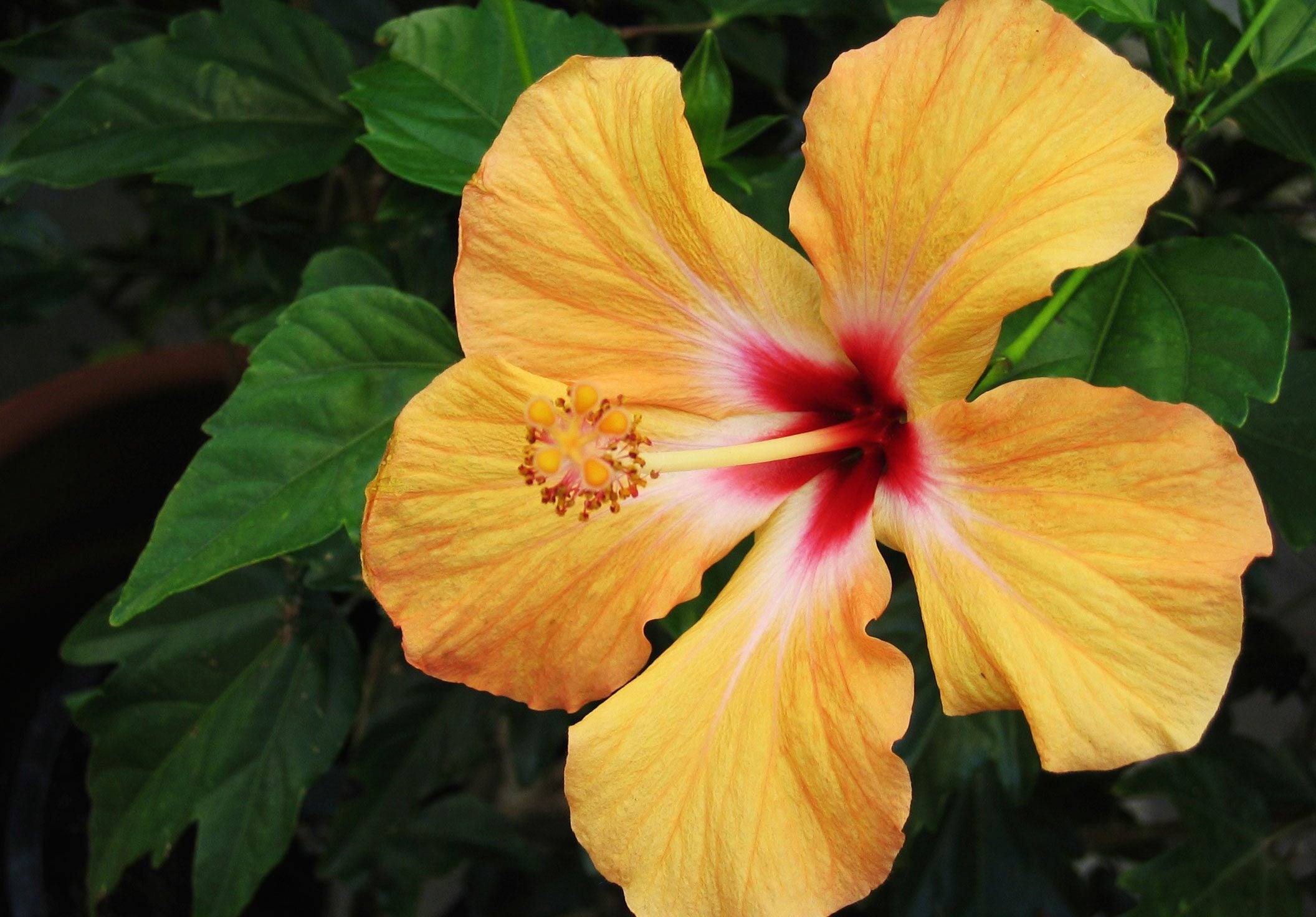How To Care For Hibiscus Plants


Mary Ellen Ellis
Hibiscus is very popular a genus of flowering plants. There are hundreds of hibiscus species that can be trees or shrubs and annuals or perennials, most of which are tropical or subtropical. There are 35 North American native hibiscus species also called rose mallows.
The type of hibiscus used most commonly in landscaping and found in garden centers is Hibiscus rosa-sinensis. This native Chinese species grows in tropical conditions but can be grown indoors in containers or as an annual outdoors.
The hibiscus flower is large, striking, and trumpet-shaped and comes in a range of bright colors. Each flower only lasts for one day, but the plant has a long flowering season. The flowers of some types of hibiscus are truly enormous, measuring up to a foot (30 cm) in diameter.
Quick Facts about Hibiscus
- Botanical name: Hibiscus spp.
- Height: 4 to 8 feet (1.2 to 3.0 m)
- Spread: 4 to 6 feet (1.2 to 1.8 m)
- Sun exposure: Full sun
- Soil requirements: Acidic, moist, rich
- Hardiness zones: 9 to 11
- When to plant: Spring
Growing Hibiscus in Containers
You can easily grow a hibiscus plant in a container to utilize limited outdoor space, to grow as a houseplant, or to have the flexibility to move it around the garden. Most hibiscus are quite large, so be sure you get a big container. It should have good drainage and be placed in a sunny window, especially if you want to see those lovely blooms.
Although warm, humid conditions are ideal for tropical hibiscus, you may want to provide outdoor plants with a little afternoon shade when it’s overly hot. Again, containers make this easy to do.
Hibiscus plants prefer a cozy fit when growing in a container. This means that they should be slightly root bound in the pot. When you do decide to repot, give the hibiscus only a little bit more room. Always make sure your soil has excellent drainage.
Temperatures for Growing Hibiscus
Tropical hibiscus varieties are extremely cold sensitive and will not tolerate winter in many locations. Daytime temperatures should be 65 to 75 F (18-24 C) and no cooler than 55 F (13 C).
Sign up for the Gardening Know How newsletter today and receive a free copy of our e-book "How to Grow Delicious Tomatoes".
If you live in a non-tropical zone and don't want to bring your hibiscus indoors, opt for a hardy variety. Hardy hibiscus species can grow in USDA zones 5 through 9 and survive year-round temperatures in these regions. Hibiscus syriacus, also known as Rose of Sharon, is a good choice. It grows more as a shrub than a tree compared to other species.
Watering Hibiscus
Moist soil is important for a hibiscus tree or shrub. On the other hand, hibiscus will not tolerate soggy soil or standing water. Make sure it grows in a spot or container with excellent drainage, and keep the soil moist at all times.
When hibiscus are in their blooming stage, they require large amounts of water. Your hibiscus will need daily watering in warm weather. But once the weather cools, your hibiscus needs far less water, and too much water can kill it. In the winter, water your hibiscus only when the soil is dry to the touch.
Fertilizing Hibiscus
A hibiscus plant needs lots of nutrients in order to bloom well.
Start with high-quality, fertile, well-draining soil with plenty of organic material. Hibiscus plants are heavy feeders and go through a lot of nutrients. Even with good soil they benefit from regular applications of fertilizer. In the summer, use a high potassium fertilizer. You can either use a diluted liquid fertilizer once a week, a slow release fertilizer once a month, or you can add a high potassium compost to the soil. In the winter, you don’t need to fertilize at all.
For an indoor, potted hibiscus, use half strength applications about every month, and less in the winter.
How to Keep Hibiscus Blooming
Hibiscus needs rich soil and nutrients, bright sunlight, and warm temperatures to flower. If you provide these conditions, it will bloom prolifically. You can also try a bloom booster fertilizer product, but this isn’t typically necessary.
Prune hibiscus plants regularly to maintain shape and size, and to encourage healthy growth that will produce more flowers.
Is Hibiscus a Perennial or Annual?
Whether a hibiscus is a perennial or annual depends on the type and where it is grown. You can grow tropical species outdoors in frost free zones as perennials, and in colder climates as annuals. Hardy hibiscus can be grown as a perennial even in cold climates.
Common Problems with Hibiscus
There are several insect pests that feed on hibiscus plants. Among the most common are aphids, Japanese beetles, thrips, mealybugs, whiteflies, and scale. Common diseases include Armillaria root rot, Botrytis blight, leaf spots, and Hibiscus chlorotic ringspot virus.
Are Hibiscus Poisonous to Dogs?
Most hibiscus are not toxic for dogs, so you don’t have to worry if they take a nibble of your plants. However rose of Sharon (Hibiscus syriacus) is a toxic species that causes gastrointestinal distress, so take care if you grow hardy hibiscus. Signs of poisoning include nausea, vomiting, and diarrhea. The same goes for cats. If you are not sure what type of hibiscus you have, assume it could harm your furry friends.
Hibiscus flowers are striking and attractive. They lend a tropical feel to patios, gardens, and indoor spaces. To grow hibiscus, know whether you have a hardy or tropical species and provide the idea conditions for years of blooms.

Heather Rhoades founded Gardening Know How in 2007. She holds degrees from Cleveland State University and Northern Kentucky University. She is an avid gardener with a passion for community, and is a recipient of the Master Gardeners of Ohio Lifetime Achievement Award.
- Mary Ellen EllisWriter